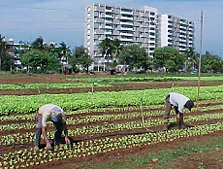Food Security, Urban Agriculture and Urban Management
Yves Cabannes
pgu@pgu-ecu.org
Marielle Dubbeling
marid@pgu-ecu.org
UMP-LAC/UNCHS-HABITAT/IPES New York- June 2001

Summary Of Presentation:
- Current challenges for municipal management
- Food security and municipal land use
- Reflections: land use policies, development policies and role of urban actors
Current Challenges For Municipal Management
Globalisation
- lengthening of distribution circuits mainly controlled by
trans-nationals
- monetarization of local systems
- disappearance of subsistence agriculture (home consumption)
access to food for poorer populations reduced
Decentralisation
- municipalities are more and more dependent on their municipal territory as principal source of employment creation and wealth
municipal territory as basis for intervention and planning

Current Challenges For Municipal Management
New Paradigm
- food security is unequivocally linked to development of agricultural, animal and fish production, transformation and commercialisation at local level, that is to say the municipal territory.
Current Challenges For Municipal Management
Consequences For Urban Management
- the relationship between Urban Agriculture(UA) and Food
Security (FS) should be better known: what is the real contribution of
UA to FS?
- it is necessary to integrate FS and UA into municipal management: in both economic, social and environmental management as well as in physical planning
link with Campaign for Secure Land Tenure
- FS and UA should be integrated into normative, legal and
operational instruments of cities: Strategic Plans, Zoning Plans,
District Development Plans, etc.
- (strategic) investment for FS and UA should be considered (micro-credit, Strategic Investment Plans, participatory budgeting)
link with Campaign for Good Governance
Municipality And City Types And Their Urbanistion Patterns
- 100% urbanised: Manta, Ecuador
- Metropolitan Area: 40% urbanised: Quito, Ecuador
- 30% urbanised: Santo André, Brazil
Food Security And Land Use Management
Potential Areas Within The City
Santiago de los Cabelleros, Domin. Rep.- Agricultural land use occupies 16% of the total urban
(inner and peri-urban) area of Santiago
- is considered a potential land-use for another 20% of the (still
vacant) area,
- and is thus the third important soil use after residential and
vacant land use.
- Agricultural land use is "on the move" (relocation), but does not disappear with urban growth (PUCMM/CEUR, 1999)
Quito, Ecuador
- 35% of the urban area of Quito is non-built up area
- however quality and quantity of potential agricultural land is
not known (Pers. Comm. D. Carrion, Dept. of Urban Planning)
Potential Areas Within The City
- Non-built up areas that are not suitable for construction
- electricity lines, river borders, wetlands, potential risk
areas (steep slopes)
- electricity lines, river borders, wetlands, potential risk
areas (steep slopes)
- Water and waste treatment areas
- Green spaces
- parks, avenues, public squares
- 1 million trees have been planted in Porto Alegre; 3.5 million are being planted in Quito, but generally these are not productive species
- parks, avenues, public squares
- Institutional private areas
- hospitals, schools, churches, graveyards
- Private areas
gardens, back-yards, patios (the conventional UA areas)
rooftops, balconies, kitchens
- (Agricultural) land under urban pressure
community, private or public land
temporary vacant construction lots
- Ecological protection areas within urban territories
for example protection of water harvest areas
Type of land use
- temporary versus permanent land use
- uni- versus multi-functional land use
- Recycling, Production (food, non-food), Transfomation and Commercialisation
 Cuenca
Cuenca
Reflections: Land Use Policies
Need to elaborate framework:
| Private | Public | |
|---|---|---|
| Land not suitable for construction | . | . | .
| Waste or water treatment areas | . | . |
| Green Spaces | x | . |
| Private instituional areas | . | . |
| Private areas | . | x |
| (Agricultural) areas under urban pressure | Tax exemption | Zoning - Symbolic rents |
| Ecological reserve areas | . | control land use |
Policy:
- Change use (zoning plans)
- Protect use (control and norms)
- Stimulate use (symbolic rents; property tax discount or exemption)
- Intensify use
Type Of Land Use And Development Policies
- Environmental protection and tree-planting policies
- Waste(water) treatment programmes linked to UA
- Facilitating policies:
- Fiscal policies
- Micro-credit programmes
- Access to research and technology
- Input supply and product distribution
- Fiscal policies
- Administrative reforms: municipal decentralisation, formation of municipal UA programmes
Type Of Land Use And Development Policies
Need to elaborate framework:| . | Recycling | Production | Transformation | Commercialisation |
|---|---|---|---|---|
| . | . | Agic-Anim-Fish | . | . |
| Social | . | . | . | Cons.-prod. linkages |
| Economic | . | Input supply | Credit | . |
| Environmental | Education | Waste-water | . | . |
NB: Define role of municipality and other actors
Encouraging:
- The inclusion of Urban Agriculture within territorial planning processes
as an element for the multiple-use of land and environmental protection.
- The development of credit and financial policies and instruments for
Urban Agriculture, with special emphasis on the most vulnerable
producers, to supplement technical assistance programs.
- Research, dissemination, awareness-raising and training in the alternative and efficient use of water; and regulations and agreements on the sanitary use of household waste water.
(Quito Declaration: 40 cities)
 Texcoco
Texcoco

![[new]](new01.gif)
